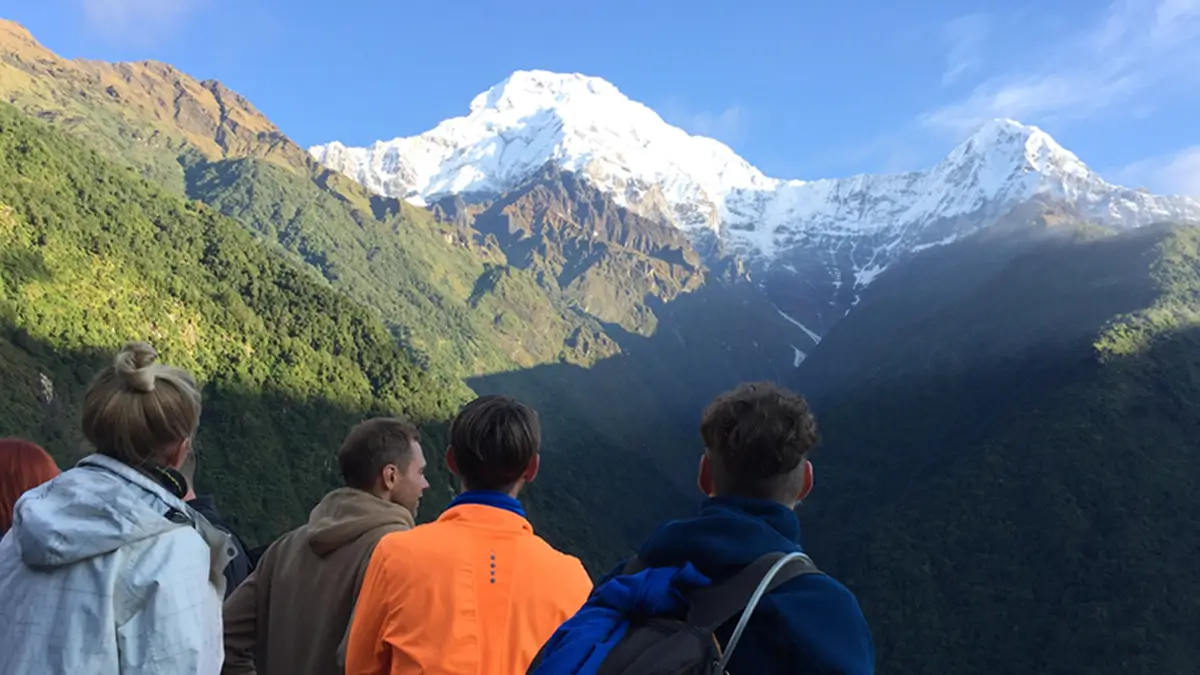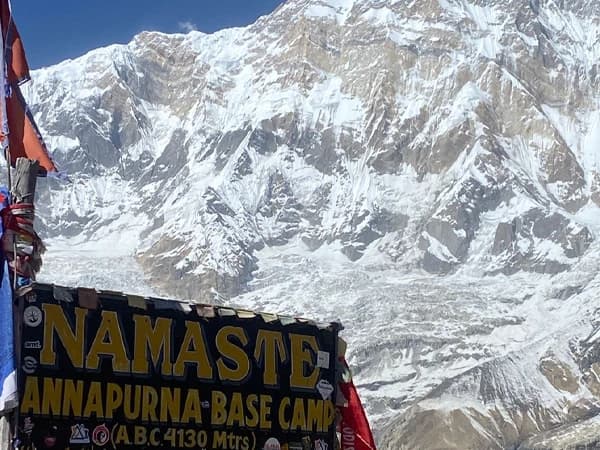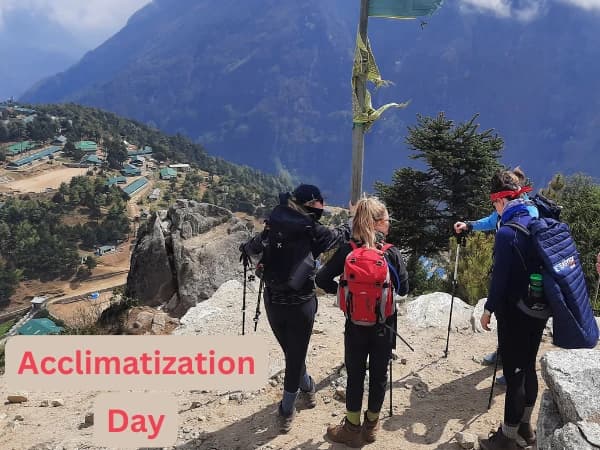The Trail Experience of Annapurna Base Camp in Spring
Your journey to Annapurna Base Camp trekking in spring often starts with a scenic drive from Kathmandu to Pokhara, overnight there and then drives to Nayapul. Your first leg day starts from Nayapul.
Early sections pass through high rolling hills, terraced rice fields, river, waterfall, some rocky trails along the way, stone-paved paths, and ancient Gurung villages. As you climb higher, pine forests give way to lush rhododendron groves that paint the hillsides with flaming colors.
The trail proceeds to Birethanti, notable for the Annapurna Conservation Area Project (ACAP) checkpoint. There is also a concrete bridge.
This is where every trek to ABC begins and ends. via routes of Poon Hill with ABC, Ghandruk to Chhomroung and ABC, or Annapurna Short Trek with Jhinu Danda.
Advancing through Chhomrong, trekkers encounter intensively cultivated terraces before entering consolidated bamboo forest zones.
Each step feels lighter because the temperatures are moderate, not the biting cold of winter or the exhausting heat of summer.
From Deurali, the ascent continues toward MBC-Machapuchare Base Camp.
Upon arrival, an unobstructed panorama of high-altitude, glaciated peaks is revealed, providing direct visual access to the region’s principal orographic features.
One final push, and you’re at ABC Base Camp. Here, peaks over 6,400m form a circle around you. It’s the closest thing to standing inside a mountain’s heart.
Highlights of Annapurna Base Camp Trekking in Spring
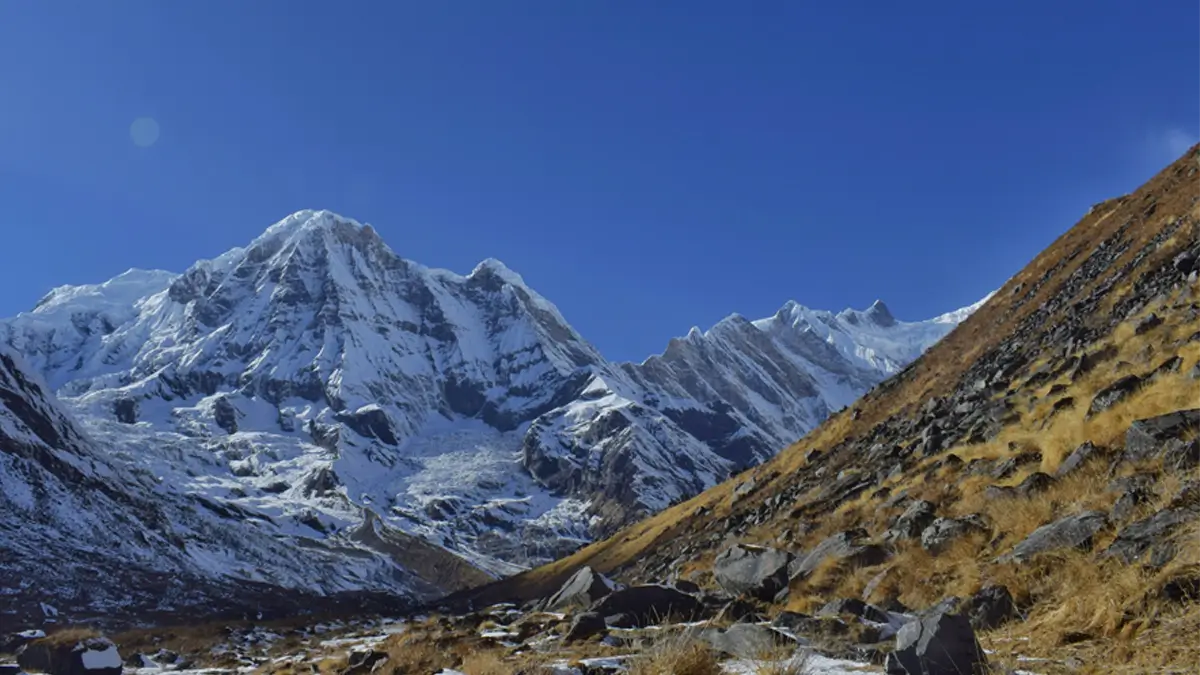
- Face to face with the 10th highest mountain on earth.
- Walk beyond the 10th highest mountain “Annapurna”
- You can immerse into sunrise painting Machapuchare’s “fish tail” tip on gold.
- You will immerse into finest sunrise over Machapuchare’s fishtail peak, with golden ray of sun hitting white, snow draped peaks.
- Immerse into Gurung culture and wild hospitality.
- Witness the magical Star-filled nights far from chaotic city lights.
- Standing in the Annapurna Sanctuary, the spiritual Amphitheater surrounded by glaciers.
- Walking from sub-tropical forests to alpine Himalayan landscapes, snowy desert type terrain in just matter of days.
- Sleep in an altitude of 4,130 m above sea level.
- Spring in Annapurna Base Camp, favors comfortable temperatures for both trekking and sleeping at higher altitudes.
- Wander around Machapuchare Base Camp (3700 meters), with panoramic and zoomed in views of snow-capped mountains.
The Spiritual Side of Annapurna Base Camp (ABC)
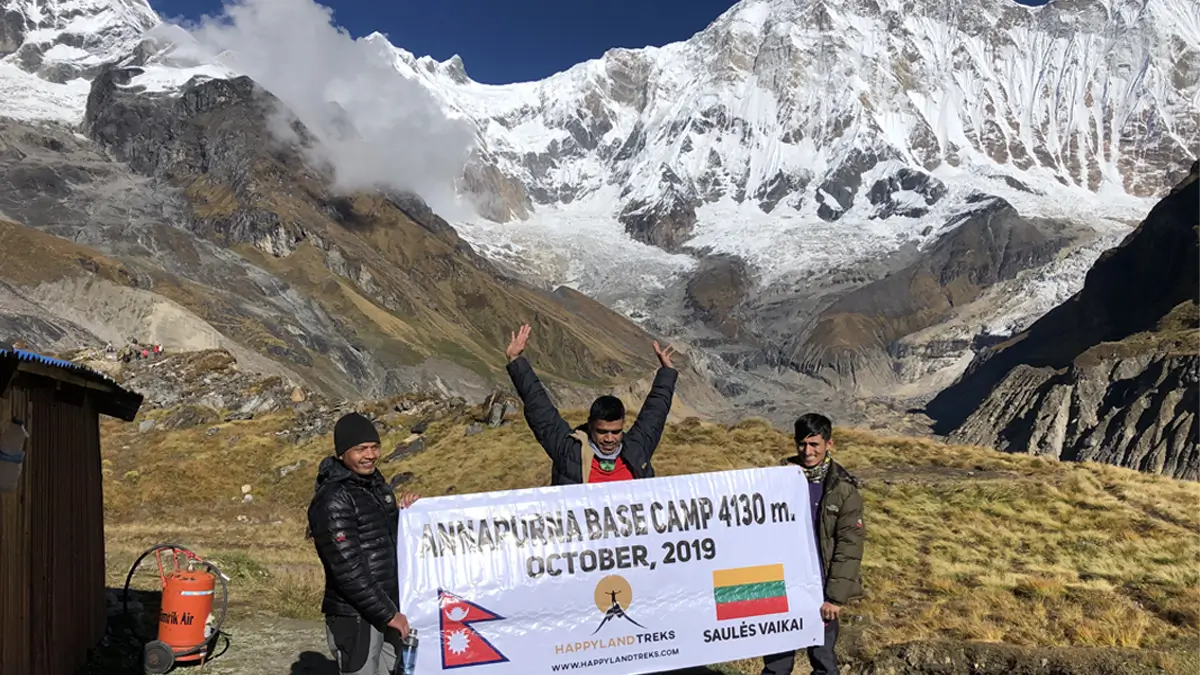
For locals, it’s a sacred ground. Many believe the mountains here are home to deities, no meat is bought above Bamboo, honoring the priority of the sanctuary.
You can soak into the spiritual ground energy of Annapurna Base Camp. Many yogis, trekkers pause here in silence, feeling the energy of this high Himalayan temple.
Stepping onto the terrain at Annapurna Base Camp, you will immediately notice this is no ordinary ground. You will walk along geological layers that’ve been stacked aur feetnd shifted over millions of years, all right under your feet.
The ground of Annapurna Base Camp Trek feels raw, ancient and deeply invigorating. The high-altitude Himalayas radiate energy that fills both body and soul.
The wind up there isn’t just a gentle breeze: it’s strong enough to make those colorful prayer flags snap like radio signals against the sky.
In higher areas of the Annapurna Himalayas, human presence is minimal, which ramps up the sense of isolation and lets you observe the site’s spiritual significance.
This is where both physical and psychological systems undergo a form of reset within the distinctive energy field of the high Himalayas.
Why Spring Turns Annapurna Base Camp into a Living Painting
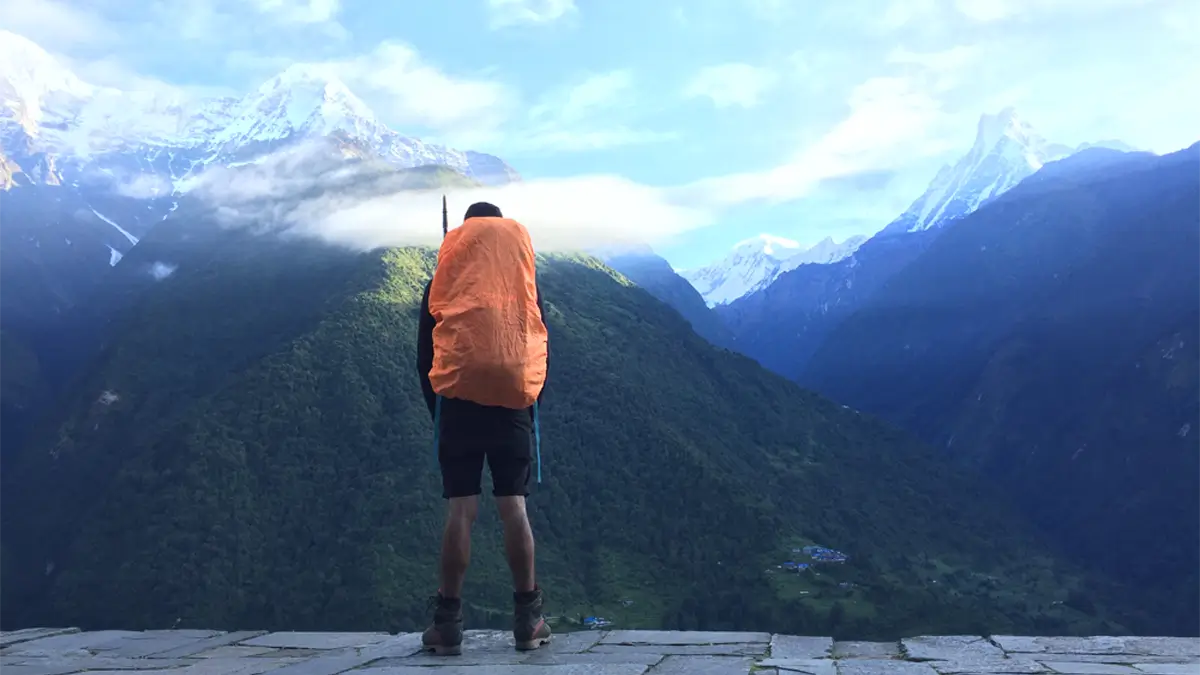
March to May is when Annapurna Base Camp trekking in spring wears her most colorful dresses. Rhododendron explode in crimson, white and pink.
Spring is when the trek comes alive. Rhododendrons dominate the trails, ranging from red, pink and white. The sky is clear. Lower valleys feel warm and welcoming, while the high peaks remain draped in snow.
Despite lingering snow on the peaks, the trails exhibit significant biological and cultural activity: endemic avifauna, prominent waterfalls, and continued evidence of regional heritage.
Imagine Machapuchare, the Fishtail, glowing gold at sunrise. Traversing beyond Annapurna I, the world’s 10th highest peak at 8,091 meters affords exceptional observational opportunities.
The confluence of comfortable weather, heightened floral diversity along the tranquil trails, and unobstructed panoramic mountain vistas collectively position spring as the most rewarding season of the trek.
Why ABC in Spring Beats Every Other Season?
The weather can change at any time in the mountains still, normally the spring offers clear mountain views of Machapuchare (Fishtail), Hiunchuli, Tharpu Chuli, Singu Chuli Peak, Gangapurna, including Annapurna I. The lowlands of the Annapurna region bloom with the scents of rhododendron and wildflowers.
Other seasons have beauty, but spring is the season of contrast. Annapurna Base Camp trekking in Spring offers warm day, crisp nights, flowers at your feet and snow on your horizon.
Annapurna Base Camp trekking in spring offers comfortable tea house stays without winter’s freezing bite. The spring season offers clear skies for mountain photography. But sometimes depends on your luck as well.
The combination of comfortable weather, vivid, colorful trails, and clear panoramic views of the mountain is the reason you should trek to Annapurna Base Camp in Spring. (Normally, October and November are also the best times to do Annapurna Base Camp)
Annapurna Base Camp Altitude and Weather in Spring
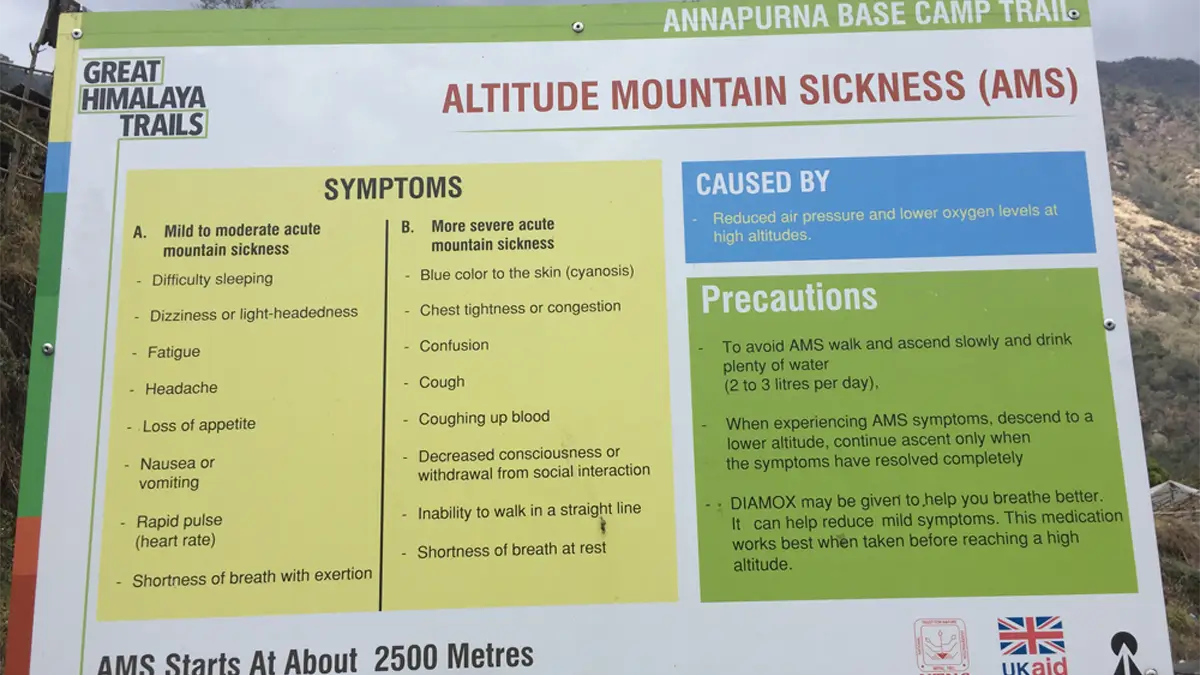
The trail begins from low-altitude villages like Nayapul (1,070m) and rises gradually to the Annapurna Base Camp in altitude of 4,130m.
One of the biggest reasons trekkers choose Annapurna Base Camp trekking in Spring is the weather.
March: Cool mornings, blooming begins, snow in higher sections.
April: Peak rhododendron bloom, warm days, crystal-clear skies.
May: Warmer, green valleys, some haze in afternoons.
Approximately, temperatures range from 12°C to 20°C during the day, dropping to near 0°C at night at higher camps. Spring brings minimal rain, making trails dry and safe.
Unlike monsoon season, spring brings minimal rainfall, so trails remain dry and safe. Unlike winter, high passes are open and snow is manageable, which makes Annapurna Base Camp trekking in spring, the perfect time for trekking.
Photography Heaven: Annapurna Base Camp Trekking in Spring
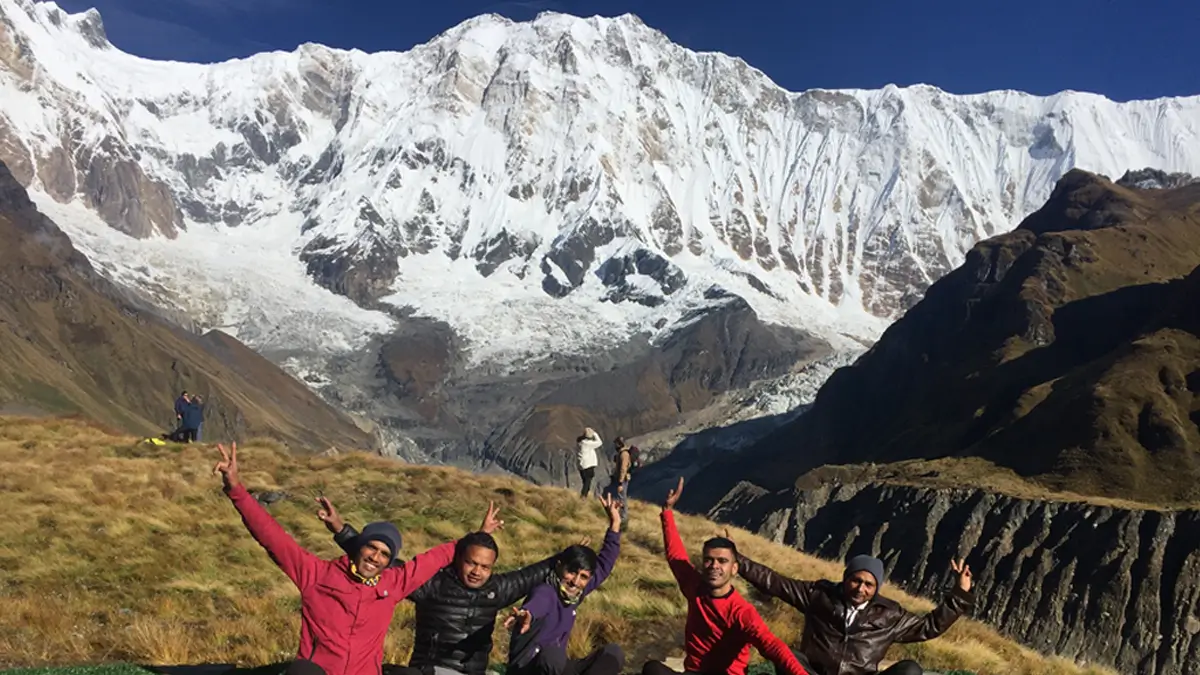
Alert! If you love photography, Annapurna Base Camp in Spring will spoil you.
If you dream of capturing Nepal’s raw beauty, Annapurna Base Camp trekking in Spring is pure magic. The contrast of red rhododendron against white peaks creates surreal frames.
Morning light over Annapurna I’s massive south face, where the first ray of golden sunlight hits white snow-covered peaks, is the moment photographers wait their whole lives for.
You’ll capture glacial rivers, prayer flags flapping in alpine winds, and villagers carrying bamboo baskets along ancient stone steps.
You’ll also capture the unique traditions, cultures of the Gurung people, local’s daily lifestyle, ancient mountain villages.
Rhododendron forests create natural tunnels of vivid color, waterfalls cascade from cliff edges and snow peaks stand majestic under cloudless skies.
Why Trekking to Annapurna Base Camp in Spring?
Trekking to Annapurna Base Camp in Spring offers a once in a lifetime experience, from blooming rhododendrons to the snow-clad Himalayan amphitheater.
The route, passing through ancient mountain villages such as Ghorepani, Tadapani, and Chhomrong, is marked by significant rhododendron blooming, which leads to a notable increase in botanical diversity and visual differentiation along the trail corridor.
You witness nature’s renewal, meet resilient mountain communities, and stand in awe before some of the tallest peaks on Earth.
Environmental conditions in spring are generally stable, with clear skies and moderate temperatures facilitating both visibility and comfort for trekkers. The snow line remains prominent, allowing for unobstructed views of major Himalayan peaks.
Trekking ABC in spring provides opportunities for cultural engagement with local mountain communities, whose adaptive strategies and resilience are evident throughout the region.
Overall, springtime conditions optimize both the aesthetic and logistical aspects of the Annapurna Base Camp trek, making it an optimal period for both ecological observation and mountaineering objectives.
The trail to Annapurna Base Camp during the spring is neither too cold nor too hot. The air smells of blooming rhododendrons.
Days are long enough to trek at a relaxed pace. Snow remains on the high peaks, but not enough to block the route.
Local agricultural cycles coincide with the trekking season, resulting in increased activity within mountain communities.
This intersection provides trekkers with a unique opportunity to observe traditional farming practices and community dynamics in real time
Annapurna Base Camp trekking in spring season contribute to a highly favorable trekking environment in terms of both environmental conditions and cultural engagement.
If you're planning to do a moderate trek with an altitude of around 4130 meters in Nepal, you should do it when the mountains are at their most vibrant. Annapurna Base Camp is it.
Cultural Encounters on the Way to ABC Trekking in Spring
Annapurna Base Camp Trekking in Spring not only transforms nature but also rural life. Annapurna Base Camp trek in Spring offers a window into Gurung and Magar traditions. You will pass stone-paved paths, terraced fields, and centuries-old houses.
Along the trail, you encounter traditional old school Gurung and Magar villages where locals typically offer friendly greetings to visitors. Villagers are engaged in agricultural activities such as preparing and planting fields, while also participating in local festivals.
In spring, local communities prepare fields for planting, celebrate local festivals, and share stories by the teahouse.
Traditional gender roles are often visible; women engaged in weaving tasks, men transporting agricultural goods using bamboo baskets, and children interacting within the vicinity of blooming orchards.
If you’re lucky, traditional music and dance performances may occur spontaneously. Visitors could also receive invitations to participate in customary tea ceremonies within local households.
The culture along the Annapurna Base Camp in Spring route adds soul to the scenery.
Wildlife, Rivers and the Melodic Sounds of Spring in Annapurna Base Camp
Spring transforms the trail to Annapurna Base Camp in Spring into a living symphony. Glacial rivers past suspension bridges, their waters shimmering under the bright sun.
As you trek, the sounds of spring follow you, rivers rushing accelerate due to snowmelt, birds singing from the forest canopy, and the crunch of your boots on stone steps.
Danphe (Nepal’s national bird) flash their iridescent feathers, langurs swing in the trees. You can also encounter Himalayan tahr grazing on the cliffside if you are lucky while on Annapurna Base Camp trekking ABC in spring.
Rivers like the Modi khola flow fast and clear, with their music blending with the wind. The harmony of sound and sight is what makes the Annapurna Base Camp in Spring unforgettable.
Tea Houses, Power, and WIFi on ABC Trekking: What to Expect
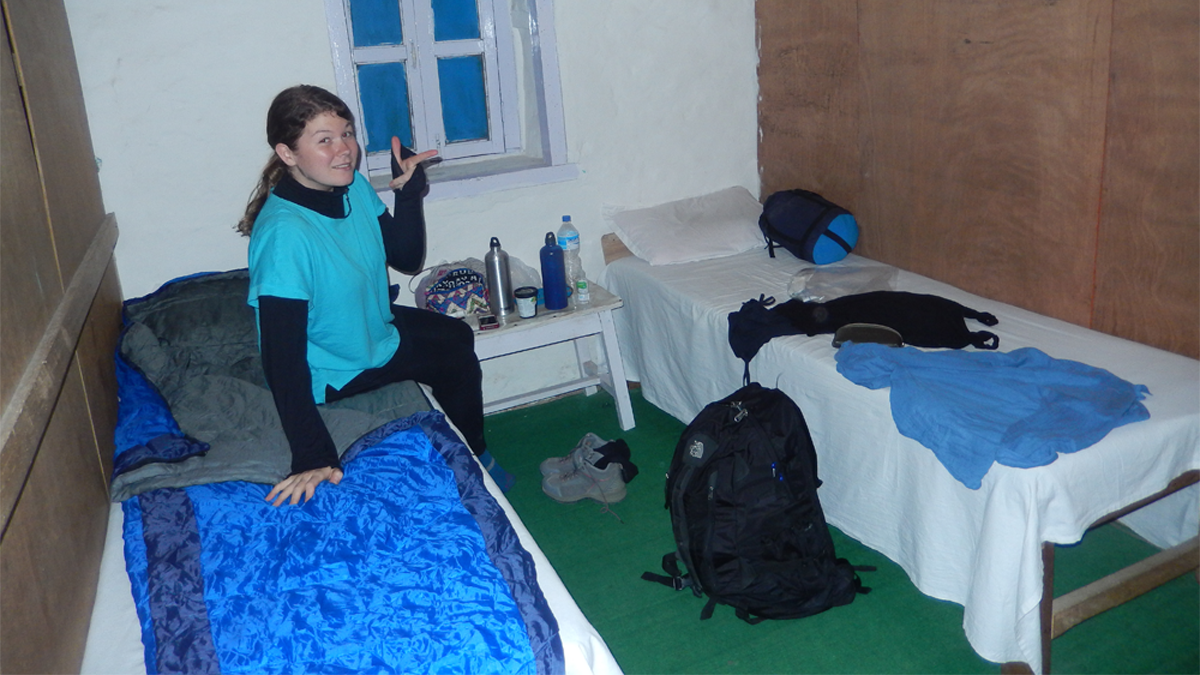
One of the basic simple accommodations to the Annapurna base camp journey, especially after the walking from the Chhomrong.
After a long day’s walk, you’re greeted by the smell of traditional mountain dishes, and local mountain rock with wooden tea houses and smiling faces eager to hear stories.
While trekking on Annapurna Base Camp in spring, teahouses are in full operation after the winter lull.
Rooms on the route of ABC are simple and cozy, with thick blankets. We can get surreal views of green rolling hills, forest, and sometimes panoramic views of snow-capped mountains from the window and dining hall.
You will have charging device in the dining room though higher up, they may run on solar and may charge a small fee. Wi-Fi is available in many of the tea houses, through speed slows in altitude.
The food from Dal Bhat to pancakes tastes even better after a long spring trek day. Plenty of choice about the food menu but normally recommend nepalese traditional food Dal Bhat once a day, Dal Vhat is comes like combo big meals including rice, curry, lentil soup, pickel.
Best Viewpoints: Annapurna Base Camp in Spring Photo Hotspots
Annapurna Base Camp
The magic of Annapurna Base Camp isn’t just the trek itself. It’s a dynamic display of high altitude geography and environmental variety. As you progress along the trail, each section unveils a new panoramic vista.
The path is most of the places of notable photographic vantage points, each characterized by distinct atmospheric conditions and geological features.
These vantage locations provide opportunities for landscape analysis, visual recording, and the capture of environmental data throughout the ascent.
The trail to Annapurna Base Camp is lined with photo hotspots, each with its own charm, mood and story. Here’s where your camera and lens will fall in love.
Machapuchare Base Camp (MBC)
At Machapuchare Base Camp (3700 meters), the mountains loom so high and appears so near that they feel like walls of ice and rock guarding the gateway to the mighty Annapurna Sanctuary.
The pyramid peak of Machapuchare (Fishtail) in the crystal clear spring air feels simply unforgettable.
Chhomrong Bridge: Balcony to the Himalayas
Perched above a deep mystical valley, the ancient mountain village “Chhomrong” is a panoramic stage for the mighty Machapuchare and the close view of the Annapurna South 7219m, and Hiunchuli 6441m.
In spring, the rooftops are often framed by blooming vivid rhododendrons, making every frame look like it belongs in a travel wonderland.
Tadapani’s Misty Morning Frames
As you sip your first tea of the day, clouds drift between dark pine silhouettes, revealing fleeting mountain peaks like secrets. And an amazing sunrise view in the morning.
This is the kind of place where your camera might get as much of a workout as your legs.
Poon Hill Sunrise View Point
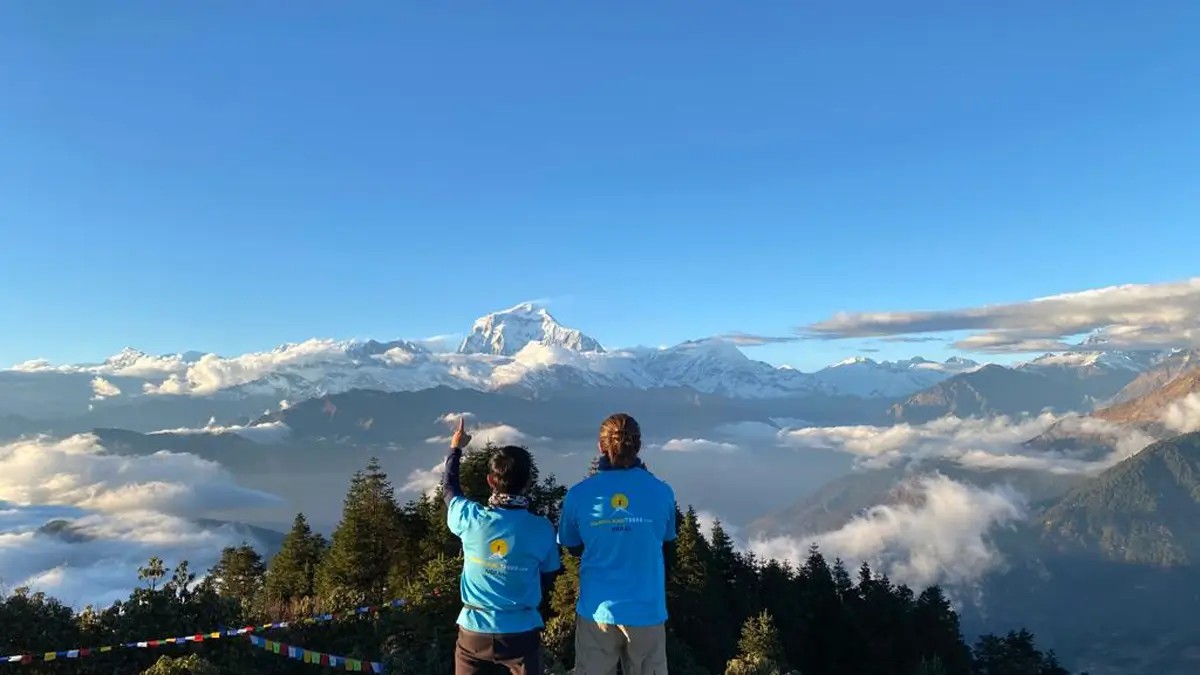
Poon Hill is a great sunrise view and the mountain viewpoint for the Annapurna Himalayas, including the 7th-heighest mountain mt. Dhaulagiri.
The first golden light spills over the white peaks over Dhaulagiri, Annapurna South, Machapuchare and a sweep of other peaks.
Poon Hill in Spring? The foreground glows with vivid rhododendron blooms, turning every shot in a postcard masterpiece, which adds vibrant color to the tranquil trails
Annapurna Base Camp- ABC Moonrise Spot
Finally, you arrive where every angle provides panoramic views of snow draped mountain views, which is worthy of a frame. You can watch peaks shift from pink to blue after dusk of snow draped peaks from Annapurna Base Camp Moonrise Spot.
Annapurna Base Camp in Spring, the amphitheater of peaks like Annapurna I (8,091m), Annapurna South (7,219 m), Hiunchuli (6,441 m), Machapuchare (6,993 m), Tharpu Chuli (5,663m), Singu Chuli Peak (6,501m) and many more glows under the sky so blue, clear and shinning.
Add the contrast of soft snow patches melting into wildflower meadows, and you have one of the rarest, rawest and magical landscapes on the entire Earth.
Bamboo and Dovan- The Mystical Forest Glow
You will walk under a canopy of mossy trees, shafts of sunlight pierce through, creating ethereal photo opportunities on the shaded forested trails of Bamboo and Dovan.
Bamboo and Dovan in Spring, the ground is carpeted with petals, rhododendrons giving each step an almost cinematic quality.
Jhinu Dada Natural Hot Spring
Imagine sitting in a warm mineral natural hot spring while the Modi Khola river crashes beside you, carrying glacial waters straight from the Annapurna peaks?
This is the magic of Jhinu Dada natural hot spring, a hidden treasure along the ABC trek trail.
Jhinu Dada natural hot spring lies beside the Modi Khola George, surrounded by caves carved into the riverside rock, dense forest of wild rhododendrons, alder, high rolling hills with high energy of nature.
About 25 minutes walking downhill to the hot spring and returning the same way uphill, about 35-40 minutes.
Massive rock formations flank the riverside, creating a natural amphitheater. The geography here feels ancient, as though nature itself carved out a secret sanctuary just for weary trekkers.
The pool at Jhinu Hot Spring is only for soaking up to the knee. We can’t swim in the pool, but we can sit and enjoy the hot natural spring water. It feels relaxing when the warm water with natural minerals comes up to our knees, and after days of trekking, soaking there is a real relief.
Jhinu Dada Suspenson Bridge
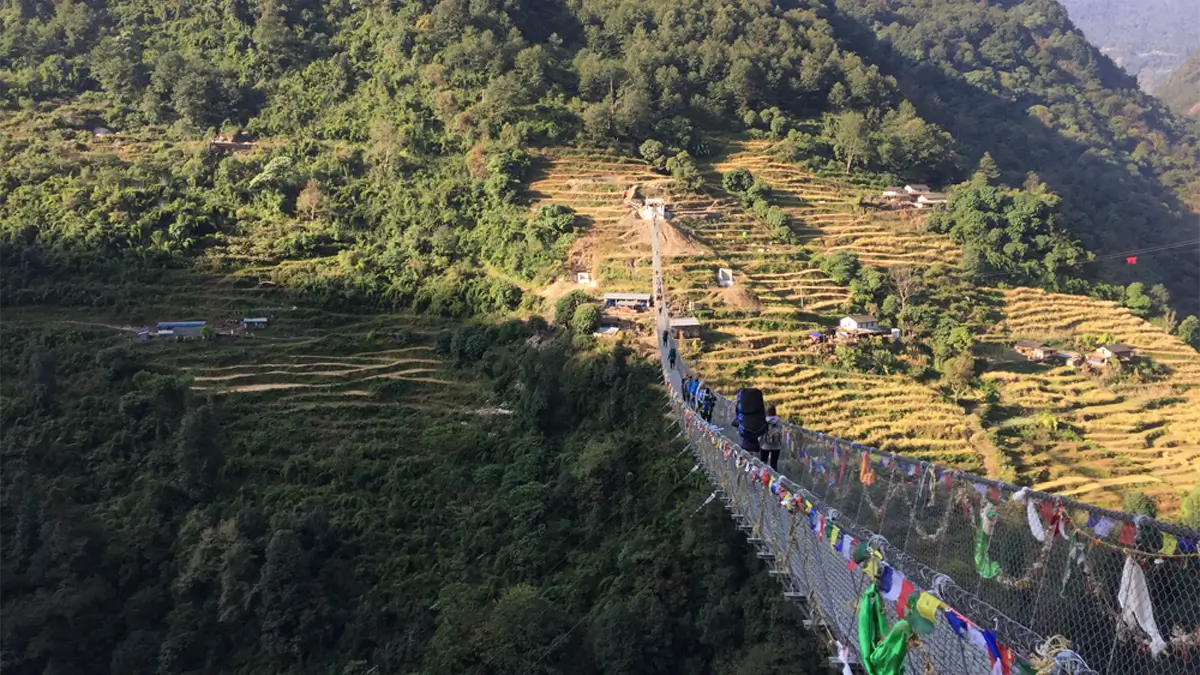
Stretching as the longest and deepest suspension bridge in the whole trek of the Annapurna Base Camp, it hangs above the Kimrong Khola, whose glacial river thunders below. The geography here is raw and dramatic.
The cliffs here hide tiny caves and rock shelters. Modi Khola looks both terrifying and mesmerizing, silver white currents dashing between dark boulders polished by time.
On either side, high rolling hills rise high with forests of oak, alder, and blooming rhododendrons that set the landscape on fire.
Ghandruk: The Living Balcony of the Annapurna Region
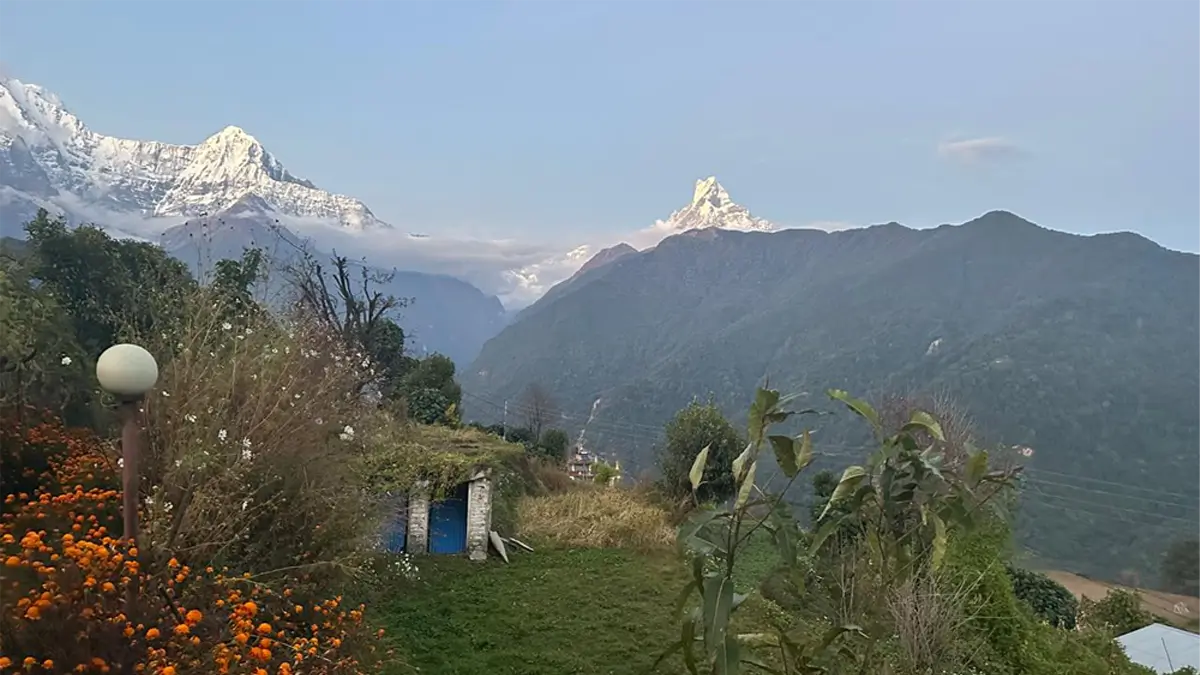
Ghandruk, perched on a gentle slope at 1,940 meters isn’t just a traditional ancient village, it’s a living balcony of the Annapurna Himalayas.
In spring, the cobbled lanes bloom with crimson rhododendrons and pink cherry blossoms, while women in traditional Gurung attire carry baskets of freshly picked vegetables along the stone steps.
The snow capped Annapurna South and Machapuchare rise high so close over the rooftops, which makes Ghandruk, a Himalayan wonderland for spiritual seekers, nature lovers, adventurers and photographers.
These vantage points make Annapurna Base Camp in Spring a photographic dream. Whether you’re a pro photographer or just shooting on your phone, the Annapurna Base Camp trail offers a visual fest at every corner and bend.
The air feels different, lighter, and each viewpoint gifts you with the pictures and the memories that keep the mountains alive long after you’ve left. Some of the tourists are also heading to ABC way from Ghandruk, like one-night stay there.
Sunrise and Mountain Views You’ll Never Forget
3210m, Poon Hill offers amazing, breathtaking sunrise views early morning over the Annapurna Himalayas, including mt. Dhaulagiri.
At Annapurna Base Camp in Spring, dawn is magic. As the first golden light spills over the Annapurna range, the peaks glow gold, pink them white.
Machapuchare reflects in frozen puddles. Annapurna I’s massive south face shines like a wall of light. These are the moments that stay in your heart forever.
Standing at Annapurna Base Camp in Spring time, watching the mountains catch fire under thew rising sun. You feel small, yet infinite. It’s the kind of beauty that stays with you forever, long after the trek is over.
Photography Tips: Annapurna Base Camp Trekking in Spring
- Shoot early morning for clear skies.
- Wake up early in the morning to capture an unbelievable sunrise over white snow draped peaks.
- Capture rhododendron backlit by sunrise.
- Use a polarizing filter to deepen blue skies.
- Keep batteries warm to avoid power loss in cold mornings.
- Include people in shorts for scale against massive peaks.
The Joy of Customizable Annapurna Base Camp Itinerary
The best part? You can always customize the itinerary according to your travel dates and the number of days you want to trek.
Want to take it slow and spend more nights in charming ancient mountain villages? You can customize the itinerary according to that.
Short on time but still want to feel the raw energy of ABC? A shorter route is possible too.
There are flexible trekking routes from Pokhara, Nayapul, Ghandruk, Poon Hill, or Phedi. You can also adjust your trekking days for proper exploration or acclimatization, side hikes or for slow paced journeys.
You can spend extra days in Machhapuchhre Base Camp just to soak in the beauty of the high Himalayas, and also the acclimatization if you have extra days.
You can also adjust your Annapurna Base Camp Trekking itinerary if you don’t have enough time but still want to explore the legendary Annapurna Base Camp:
The Annapurna Himalayas welcome everyone differently, and the beauty of trekking here is that you can shape your adventure to match your time, pace and spirit.
The trail can bend to your will, giving you the freedom to craft your own Himalayan story.
Different Itineraries: Choose and Customize The Perfect Annapurna Base Camp Journey For You
Annapurna Base Camp Trek isn’t a “one-size-fits-all” trek. It’s a trail where the mountains stay same, but the way you approach them is entirely yours.
Whether you have few days to spare or two full weeks to immerse in the heart of the Himalayas, there’s a version waiting for you. And yes, every single one can be tailored to your style, pace and travel dates.
If you have limited time, in just one week, you can pick the Annapurna Base Camp short trekking-7 days. In just less than one week, you’ll still stand in the heart of legendary Annapurna Sanctuary; queen of icy thrones.
If you have more time to spend in the High Himalaya, the Annapurna Base Camp Trekking-13 days is your golden path.
This longer journey lets you explore side trails through Ghorepani, Poon Hill and many more ancient villages, viewpoints you’d miss on the shorter route.
And the main part, the itinerary, is never locked. You can customize your itinerary.
Want to shorten the days? Add cultural villages? Or stretch it into a longer adventure with exploration of side and hidden destinations? The Annapurna trail is as flexible as your dream.
Annapurna Base Camp Trekking-13 Days
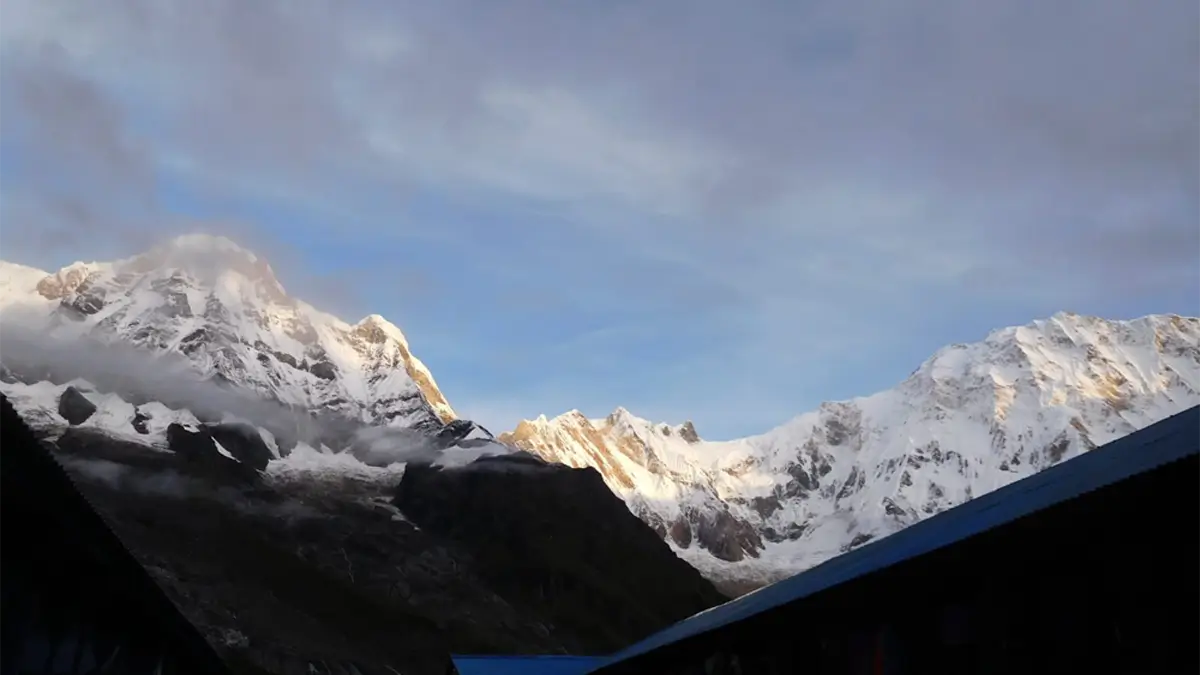
If you want to savor every ridge, hidden Himalayan treasures, mountain village and sunrise without rushing, the Annapurna Base Camp trek-13 days is the gold standard.
Annapurna Base Camp Trek-13 days is long enough to let the mountains become familiar friends, with plenty of room for side hikes, slow mornings, and moments where you simply stop and breathe in the raw scent of spring blossoms on the wind.
This trek weaves you through the side destinations, the most short routes miss. You ascend through ancient mountain villages like Ghorepani or Poon Hill, one of the Nepal’s famous viewpoints.
You will experience one of the trek’s most rejuvenating stops on the second last day at Jhinu Dada Hot Spring. On the final day of the Annapurna Base Camp Trekking- 13 days, you will cross Jhinu Dada suspension bridge, the longest and deepest in the whole trekking journey.
This Annapurna Base Camp Trekking-13 days itinerary is designed for proper acclimatization and side hidden destinations. Each village stop, whether it’s Tadapani, Chisapani, or Himalaya unfolds a new story, cozy tea houses.
After witnessing the first golden rays of sun white striking Dhaulagiri, Machapuchare, Annapurna I, Annapurna South, Tharpu Chuli, Singu Chuli peak, you will realize why this detour is worth every step.
Outline Itinerary- Annapurna Base Camp Trekking-13 Days
Day 01: Kathmandu arrival and transfer to your hotel.
Day 02: Kathmandu to Pokhara and overngiht in Pokhara (optional flight or drive)
Day 03: Pokhara to Nayapul drive and trek to Ullery (2010m)
Day 04: Trek Ullery to Ghorepani (2874m)
Day 05: Trek Ghorepani to Poon Hill (3210m) to Tadapani (2610m)
Day 06: Trek Tadapani to Sinuwa (2310m)
Day 07: Trek Sinuwa to Deurali (3210m)
Day 08: Trek Deurali to ABC-Annapurna Base Camp (4130m)
Day 09: Trek ABC to Bamboo (2310m)
Day 10: Trek Bamboo to Jhinu Danda (1780m)
Day 11: Jhinu to Pokhara drive (820m)
Day 12: Pokhara to Kathmandu (optional flight or drive)
Day 13: Departure day or stay longer.
Annapurna Base Camp Short Trekking-6 Days
Time-crunched adventures will find joy in the Annapurna Base Camp Short Trekking-6 days of distilled Himalayan magic.
The Annapurna Base Camp Short Trekking-6 days is quick, yet rich, giving you rhododendron blooms, snow-brushed peaks, and the triumphant stand at base camp, all in less than a week.
On this route, you move directly towards the base camp, trekking through high rolling hills, terraced farmlands, lush rhododendron forests and ancient mountain villages.
From here, you retrace the same trail back, each step letting you see the landscapes from a new angle.
This 6 days, trek to mighty Himalayas might be shorter, but it leaves no less than a imprint.
You can soak into panoramic sunrise views that paint the Himalayas in fire and gold.
It’s perfect for trekkers who want to breathe in the Annapurna Base Camp experience in a single week, while still carrying a lifetime memories. But a 6-day trekking duration is the way you're going uphill the same way as walking back.
Outline Itinerary-Annapurna Base Camp Short Trekking-6 days from Pokhara
Day 01: Drive from Pokhara to Jhinu and trek to Sinuwa (2300m)
Day 02: Trek Sinuwa to Himalaya (2900m)
Day 03: Trek Himalaya to Annapurna Base Camp-ABC (4130m)
Day 04: Trek ABC to Bamboo (2310m)
Day 05: Trek Bamboo to Jhinu Danda (1780m)
Day 06: Trek 15-20 minutes from Jhinu Danda and take a transport to Pokhara.
A reminder! Whichever itinerary you choose, remember every single package is fully customizable.
You can shift your travel dates, stretch a short trek into a slower journey, or trim a long trek to match your schedule.
In the end, your Annapurna Base Camp Trek will be as unique as your footprints on the trail of High Himalayas.
FAQs- Annapurna Base Camp Trekking in Spring
Is Spring the Best Time for Annapurna Base Camp?
Yes, clear skies, moderate temperatures, and blooming rhododendrons make spring the best, most beautiful and comfortable trekking season for ABC Base Camp trek.
How Long Does the Annapurna Base Camp Trek Take in Spring?
The itinerary is customizable; you can create your own itinerary according to the days you want to travel. The recommended itinerary takes 9-14 days, depending on your pace and starting point.
Do I Need Permits for Annapurna Base Camp in Spring?
Yes, you will need the Annapurna Conservation Area Permit (ACAP) and a TIMS card for Annapurna Base Camp trek in Spring.
Are There Snow-Covered Trails in Spring?
Yes, higher sections may have light snow, adding to the beauty without blocking the route.
Is Annapurna Base Camp Trekking in Spring Safe for Beginners?
Yes, with gradual acclimatization, proper gear, and a guide, it’s one of the best treks for first-timers in Nepal.
Can I See Machapuchare from the ABC Base Camp?
Absolutely, Machapuchare (fishtail) dominates the view and looks even more magical during spring from Annapurna Base Camp.
How Cold is Annapurna Base Camp in Spring?
At Annapurna Base Camp, approx 10–15°C during the day and -3 to 5°C at night, perfect for clear skies and starry nights. (but the weather changes a lot, so temperatures can change as well)
Is Spring a Good Time to Trek in Nepal?
Yes, Spring is the best time to trek in Nepal.
What’s the Weather Like in Spring in Nepal?
Spring in Nepal, especially March to May, is a trekkers dream. The morning is crisp, the afternoons pleasantly warm, and evening is cool enough to cozy up by the fire. Skies are usually crystal clear.
Where do Rhododendron Bloom on the ABC-Base Camp Trek in Spring?
The rhododendrons bloom in many places, like from Banthanthi to Nangethanthi, Ghorepani, Poon Hill, Thapla Danda, like the second Poon Hill viewpoint, Tadapani, Chuile, Chhomrong Danda, up to the Deurali. And also the way downhill to Jhinu Danda.
What is the Temperature of Annapurna Base Camp Trek in Spring?
Not too cold during the spring season in the Annapurna base camp during the daytime. But in the evening or night, of course, it is cold. The temperature can be approximately like 10-15 degrees during the day. and during the night expect -1 to 10°C at night.
Is Hiring a Guide and Porter Necessary for the Annapurna ABC Trek in Spring?
Taking a guide or a porter to the Annapurna Base Camp, it is up to you, but normally hiring a guide or a porter is more beneficial for you as well as for the local operator in Nepal.
It is safe and secure, with easy travel access without problems. And you will learn more about the nature, culture, and their people with a guide.
They will also get employed and paid. Porters allow you to walk lightly and enjoy the journey without any strain.
Do I Need Permits for ABC Trek in Spring?
Yes, you need the ACAP permit and sometimes a required TIMS CARD as well for the ABC trek.
Is WI-Fi Available on the Tea Houses of ABC?
Yes, WI-Fi is available in most teahouses, though it slows at higher altitudes. Some trekking teahouses may charge a small fee for the wifi.
